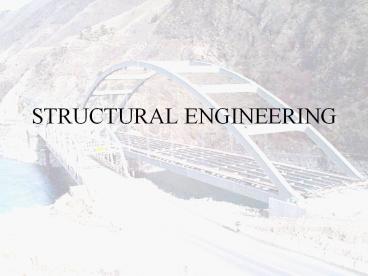STRUCTURAL ENGINEERING - PowerPoint PPT Presentation
1 / 29
Title: STRUCTURAL ENGINEERING
1
STRUCTURAL ENGINEERING
2
What Does a Structural Engineer Do?
3
What Does a Structural Engineer Do?
4
Roles of a Structural Engineer
- Lead engineer/Project engineer
- Consultant for an architect
- Consultant for another engineer, insurance
companies, lawyers, etc. - As well as
- Aerospace design.
- Product design, etc. for industries.
- Facilities engineer.
5
Lead or Project Engineer
- Defines project goals
- Costs
- Performance requirements
- Supervises design based on these requirements.
- Outlines tasks
- What needs to be done who will do it
- Organizes Project
- Calendar
- Sequence
6
Palm Valley Interchange
7
Lower Granite Dam Lock Repair
8
Consulting for an Architect or Engineer
- The architect works with the client to establish
project requirements - space requirements and relationships
- siting
- aesthetics
- lighting
- finishes
- budget
9
Consulting for an Architect or Engineer
- The engineers job is to make the architect look
good. - Ensure integrity of structure
- Provide economical solutions.
- Develop innovative ways to solve new problems and
use new materials.
10
Boise Air Terminal
11
Design Process
- Conceptual design
- Layout (location, size, shape, spans)
- Materials (steel, concrete, masonry, timber)
- Performance requirements
- Cost estimates
12
Design Process (cont.)
- Preliminary Design
- Layout framing
- Rough sizing of members foundation
- Interaction with mechanical, electrical, etc.
13
Design Process (cont.)
- Final Design
- Detailed analysis
- Final member sizes
- Preparation of bid documents
- Inspect and review construction process.
14
Day-to-Day Tasks
- Beginning
- Quantity take -offs
- Checking shop drawings
- Inspecting construction
- Repetitive simple designs
15
Day-to-Day Tasks
- Intermediate
- Developing complex computer models
- Analyzing wind or earthquake loads
- Creating complex designs
16
Day-to-Day Tasks
- Advanced - Working directly with client
- Establish project performance criteria
- Select structural framing system and layout
- Estimating costs
17
Design Loads
- Design loads include
- Dead loads
- Self-weight,
- Permanent contents.
- Live loads
- Occupants,
- Transient contents
- Environmental loads
- Wind, snow, earthquake, etc.
18
Uncertainty
- Dead loads can be predicted with some confidence.
- Live load and environmental load predictions are
much more uncertain. - E.g., it is nearly impossible to say what will be
the exact maximum occupancy live load in a
classroom. - It is also difficult to say how that load will be
distributed in the room.
19
Uncertainty (cont.)
- Structural codes account for this uncertainty two
ways - We chose a conservative estimate (high-side
estimate) for the load - E.g., a 50-year snow load, which is a snow load
that occurs, on average, only once in 50 years. - We factor that estimate upwards just to be sure.
20
Load Factors
- Newer codes have separate load and resistance
factors - Load factors overestimate the load.
- Resistance factors underestimate the strength
of the structure. - Dead load factors range from 1.1 to 1.4
- Smaller uncertainty.
- Environmental and live load factors range from
1.7 to 2.0 and higher. - Higher uncertainty
21
Design Loads
- Since we cant predict exactly the maximum load a
given structure will experience, the design codes
provide - Rational procedures for estimating a reasonable
maximum value - Procedures for arranging the loads on the
structure. - Experience has shown that if the engineer follows
these procedures he/she can expect the structure
to perform properly (I.e., not collapse, etc.)
22
Wind Loads
- What factors should the wind design loads
consider?
23
Wind Loads
- Current codes consider
- Maximum wind speed expected at the location in
question - Maximum speed in a 3-second gust with a 50-year
return period. - This is based on historical data
- Coastal regions, such as Florida, have higher
design wind speeds than most inland areas.
24
Topography
- Codes consider the effects of general topography.
- E.g, inland vs. exposed coast.
- They also consider local terrain
- Exposure factors account for shelter provided by
surrounding buildings and trees. - Standard wind speed measurements are based on
moderate topography and terrain.
25
Building Height
- Codes also account for the fact that wind speeds
tend to increase with height. - Standard measurements are made 33 ft (30 m) above
the ground.
26
Aerodynamics
- Codes must also consider the drag forces
generated by the wind. - The drag coefficient is based on
- The shape of the building
- Rectangular vs. rounded, etc.
- Whether building is open or closed
- Based on the number of windows and doors
- Windward vs. leeward forces.
27
Importance Factor
- Codes also consider how important the building
is. - If the building is a hospital that must remain
functional during a hurricane, the design wind
loads must be increased. - If the building is an agricultural storage
building that doesnt endanger anything nearby,
the wind loads can be decreased.
28
Summary
- Design loads used by engineers represent rational
estimates of loads that we should consider in our
design. - Experience has shown if we design for these
loads, the building should survive for a
reasonable amount of time (50 years or more).
29
Summary (cont.)
- The models try to consider situations that will
have a significant effect on the design load. - Max wind speed, topography and terrain, building
height and shape, etc. - The maximum loads estimated by the design codes
are then factored to add a safety margin to our
calculations.































